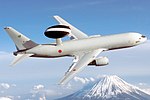| Name
|
Role
|
Manufacturer
|
Notes
|
Year of
first flight
|
Introduction
|
Number built
|
Image
|
| Douglas EB-66
|
Electronic warfare
|
Douglas Aircraft Company
|
Used by United States Air Force to jam North Vietnamese SAMs, MiG-21s, and anti-aircraft guns.[8]
|
|
1965, By[8]
|
At least 99[9]
|

|
| Grumman EA-6A "Electric Intruder"
|
Electronic warfare (EW)/Electronic countermeasures (ECW)
|
Grumman
|
Converted Grumman A-6 Intruder designed for the United States Marine Corps, designed to provide a new ECM platform to replace the EF-10B Skyknights and AD Skyraiders; it served with the USMC during the Vietnam War in 1966.[10][11][12] The last EA-6A had been retired by 1993. Later upgraded into the Northrop Grumman EA-6B Prowler.[10][12]
|
Unknown
|
1965[10]
|
27[13]/28
|

|
| Boeing EC-135
|
Airborne Command Post, Airborne Launch Control Center, Tracking and Telemetry Platform, Airborne Radio Relay
|
Boeing
|
Developed from the Boeing C-135 Stratolifter. Replaced by the Boeing E-6 Mercury.
|
Unknown
|
1965
|
Unknown
|

|
| Grumman EA-6B Prowler
|
Electronic warfare/Attack aircraft
|
Grumman
Northrop Grumman
|
Improved version of the Grumman EA-6A. Replaced by the EA-18G Growler in 2015 in the U.S. Navy and was retired in March 2019 with the U.S. Marine Corps.[11]
|
1968[11]
|
1971[10]
|
170[14]
|

|
| Lockheed EC-130
|
Psychological and Information Operations (EC-130J)
|
Lockheed
Lockheed Martin
|
One of the many variants of the Lockheed C-130 Hercules.
|
Unknown
|
1975
|
7
|

|
| Boeing E-3 Sentry
|
Airborne early warning and control
|
Boeing Defense, Space & Security
|
Developed from the Boeing 707-320.[15]
|
EC-137D: 9 February 1972
E-3: 25 May 1976[16]
|
1977[17]
|
68
|

|
| Boeing E-4
|
Airborne early warning and control
|
Boeing
|
Developed from the Boeing 747-200
|
1973
|
1974
|
4
|

|
| Windecker YE-5
|
Experimental stealth aircraft
|
Windecker Industries
|
Developed from Windecker Eagle
|
1973
|
Never
|
1
|
|
| Lockheed EC-130H Compass Call
|
Electronic warfare (EW), Suppression of Enemy Air Defenses (SEAD), offensive counter-information
|
Lockheed (airframe)
BAE Systems (prime mission equipment)
L3 Communications (aircraft integration and depot maintenance)
|
One of the many variants of the Lockheed C-130 Hercules.
|
Unknown
|
1983[18]
|
14
|

|
| General Dynamics–Grumman EF-111A Raven
|
Electronic warfare
|
General Dynamics, conversion by Grumman
|
Developed from the General Dynamics F-111 Aardvark.
|
1977
|
1983
|
42[19]
|

|
| Boeing E-6 Mercury/Hermes
|
Airborne command and control
|
Boeing
|
Developed from the Boeing 707-300; utilizes TACAMO; planned to be replaced by the TACAMO Recapitalization Program (E-XX); replaced the EC-135.[20]
|
1987
|
1989[20]
|
16
|

|
| Northrop Grumman E-8 Joint STARS
|
Airborne Battle Management and ISTAR
|
Northrop Grumman
|
Developed from the Boeing 707
|
1988[21]
|
1991
|
17
|

|
- E-9A Widget
|
|
|
A United States Air Force De Havilland Canada Dash 8 range control aircraft that ensures that the overwater military ranges in the Gulf of Mexico are clear of civilian boats and aircraft during live fire tests of air-launched missiles and other hazardous military activities.[22][23] The 82nd Aerial Targets Squadron located at Tyndall AFB, has the only E-9A aircraft in the Department of Defense inventory.[23]
|
Unknown
|
1988 (IOC)[23]
|
2[23]
|

|
| Northrop Grumman E-10 MC2A
|
Airborne early warning and control
|
Northrop Grumman / Boeing Integrated Defense Systems
|
Based on the Boeing 767-400ER, project later cancelled.[24]
|
Never
|
Never
|
0
|
|
| Boeing E-767
|
Airborne early warning and control
|
Boeing Integrated Defense Systems
|
Boeing E-3 Sentry's surveillance radar and air control system installed on a Boeing 767-200; used by the Japan Air Self-Defense Force.[25]
|
- 1994 (without rotodome)
- 1996 (with rotodome)
|
2000
|
4
|

|
| Boeing E-7 Wedgetail
|
Airborne early warning and control
|
Boeing Defense, Space & Security
|
Based on the Boeing 737 Next Generation. Also known as the E-737 or Boeing 737 AEW&C
|
2004
|
2012
|
14
|

|
| Boeing EA-18G Growler
|
Electronic warfare aircraft
|
Boeing
|
Electronic warfare version of the Boeing F/A-18E/F Super Hornet. It's built to replace aging EA-6B Prowlers. It also retains the Super Hornets' multi-mission and SEAD capabilities.[26]
|
2006[26]
|
2009[26]
|
172 as of October 2021
|

|
| EA-37B Compass Call
|
|
|
USAF Gulfstream G550 fitted for Electronic Warfare to replace existing EC-130H Compass Call aircraft.[27][28] Previously known as EC-37B, on November 14, 2023, Air Combat Command redesignated the platform as EA-37B to better identify its mission of finding and attacking enemy land or sea targets.[29][30]
|
Unknown
|
Unknown
|
Unknown
|
|
| Lockheed EP-3
|
Signals Intelligence (SIGINT)[31]
|
Lockheed Corporation
|
Electronic signals reconnaissance variant of the Lockheed P-3 Orion.[31]
|
Unknown
|
1960s, late -early 1970s[32]
|
12[32]
|

|